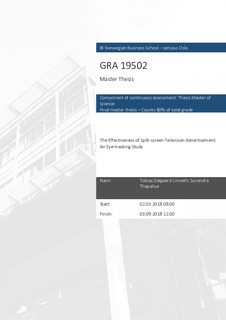The Effectiveness of Split-screen Television Advertisement: An Eye-tracking Study
Master thesis
Permanent lenke
http://hdl.handle.net/11250/2580233Utgivelsesdato
2018Metadata
Vis full innførselSamlinger
- Master of Science [1621]
Sammendrag
In the regular format (full-screen) of advertisement, viewers have multiple ways to
avoid exposures to the advertisement. To reduce such Ad avoidance behavior, another
form for television advertising, the split-screen format has been proposed as an
alternative. The present study aims to identify the effect of this alternative
advertisement format on ad processing. An empirical investigation was conducted to
compare the full-screen format and split-screen format of advertising, in terms of visual
attention and brand memory. Results indicate that there is no direct relationship
between screen format and memory for the brands being advertised. However, the
indirect effect through visual attention was significant. In contrast to our prediction,
compared to split-screen, the full-screen format increases visual attention on
advertisement and consequently brand memory. We additionally investigated whether
program involvement level (in term of sports interest and cycling interest) moderate
the relationship and found out that full-screen format leads to higher visual attention
and brand memory than the split-screen format in low and medium program
involvement level, whereas there is no difference in two formats for high involvement
program.
Beskrivelse
Masteroppgave(MSc) in Master of Science in Strategic Marketing Management - Handelshøyskolen BI, 2018
